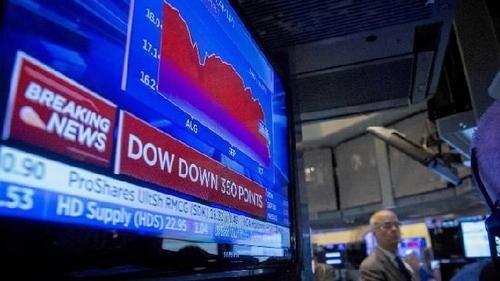Stock Investors Are Jittery But No Panic Selling—Yet
Post on: 10 Июль, 2015 No Comment

AFP | Getty Images
Japan's share prices plunged across the board after reports of rising radiation.
On most trading floors, in fact, the mood instead was serious concern—not hysteria—that the snowball of global and geopolitical events was about to choke off the market’s two-year rally.
The huge market drop. then, was not 2008 all over again, but rather a warning shot that many investors have their fingers on the sell button should the Japan natural disaster or the Middle East tumult take a serious turn for the worse.
If we can avoid a (further) major catastrophe in Japan and people are capable of going back to work and society can go on there, then there is a chance for this only being a corrective-type pattern, said Brian LaRose, strategist at United-ICAP in New York. Fundamentally this would appear to be a safety play, not necessarily a panic move out of the market.
For LaRose, the market’s move lower fulfilled his company’s forecast that the most bullish case for stocks would be a rise to 1,350 in the Standard & Poor’s 500. The index approached that level in February but fell about six points short and has been declining ever since.
As such, the days ahead represent a serious challenge.
LaRose sees 1,225 as the next downside test. Should that fail, he thinks 1,130 comes into play. And if that level does not hold up, he sees nothing but gravity and the broad index tumbling below its 666 intraday low on March 6, 2009.
I haven’t seen anyone panic-selling, he said. Anyone holding a position is merely being cautious at this point.
The most serious question at this point seems to be how bad the nuclear situation is in Japan. Should a Chernobyl-level meltdown occur, that also would strangle Japan’s economy and put a huge dent into global demand, in addition to the unimaginable human toll.
All bets are off in that scenario, warned Marc Faber, publisher of the Doom, Gloom and Boom report and the man often referred to as Dr. Doom.
But the chance of that happening is seen as remote, at least for now.
The bottom line is, yes, there’s the possibility of a meltdown. But it seems that they are doing a pretty good job in trying to prevent it, said Mark Mobius, CEO of the Templeton Emerging Markets Group. In an environment like this, no one, not even the great experts, know what’s going to happen next.
The sell-off, he said in a CNBC interview, was more about buyers heading for the sidelines than sellers taking over the market.
A lot of people are saying, ‘I don’t know what’s going to happen. It’s uncertain, therefore I’m going to take profits,’ and then you have that selling, he said. And of course, some of it is just panic. You want to get into cash and just wait to see what happens.
The delicate nature of the situation in Japan made impulse-selling tough to resist, as the world literally was watching which way the wind was blowing to see where the radiation from nuclear plants would drift .
You liquidate and you get a position where you can get defensive. Tactically you get ready to do something because there’s so little information, Brian Battle of Performance Trust Advisors told CNBC. If we’re using the wind direction to make an investment decision, that’s not good strategy. So go to the ground.
Todd Horwitz, chief strategist for the Adam Mesh Trading Group in New York, was looking for selective areas to make decisions, buying solar stocks for instance as the tree huggers come out again against nuclear energy. Indeed, the Guggenheim Solar ETF, which tracks solar stocks, was one of the biggest strength areas in the market during the drop.
Overall, the market is likely to struggle for now but Horwitz thinks panic is unlikely. Indeed, the market headed into the afternoon part of the session well off its lows for the day.
There was a little panic overnight, he said. Now that cooler heads have prevailed it’s more orderly. This was much expected and Japan was just the catalyst to do it.














